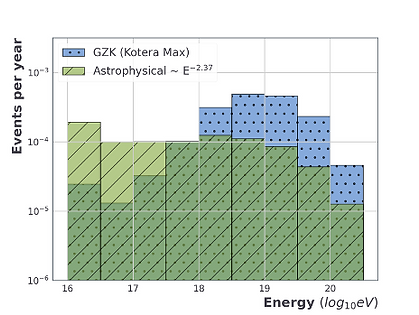NEUTRINO PHYSICS
Ultra-high energy (UHE) neutrinos (𝐸 ≥ 10^17 eV) are a decisive piece in the field of multi-messenger astrophysics. Recent achievements in this field include the discovery of a high-
energy (TeV-PeV) astrophysical neutrino flux, the first detection of gravitational waves, and the precise measurement of cosmic rays and gamma rays at their largest detectable energy
limits. UHE neutrinos could reveal the nature of cosmic accelerators that generate cosmic
rays (protons or nuclei) exceeding 10^20 eV.
UHE neutrinos likely originate from both inside astrophysical sources (Active Galactic Nuclei, Gamma Ray Burst, and Supernovae Remnants) through hadronic processes and from interactions like the Greisen-Zatsepin-Kuzmin (GZK) effect, where extragalactic cosmic rays with energies above 10^19.5 eV interact with the cosmic microwave background within tens of Mpc of their origin. Therefore, these neutrinos would point close to the cosmic ray production site. Unlike cosmic rays and high-energy photons, neutrinos are not deflected or absorbed, making them ideal for tracing the most energetic cosmic accelerators.
HE and UHE neutrinos are also powerful probes of Beyond Standard Model (BSM) physics. Their extreme energies (4 to 7 orders of magnitude above the LHC) and long propagation distances provide a unique window into exotic phenomena. These include Lorentz Invariance Violation, non-standard interactions, and sterile neutrinos, which could leave signatures in their cross-sections or flavor composition.
To test these possibilities, we need data.

Credit: Mauricio Bustamante
When UHE neutrinos interact in dense media like South Pole ice, they produce coherent radio pulses through the Askaryan Effect, a form of radio-Cherenkov radiation. Experiments like the Askaryan Radio Array (ARA), located at the South Pole, are designed to detect these radio signals using antennas embedded deep in the ice. Because radio waves can propagate for kilometers in ice with minimal attenuation, radio-based detection offers a scalable, cost-effective way to detect UHE neutrinos.

Credit: ARA Collaboration
I am a member of the ARA Collaboration, contributing across analysis, detector operations, and developments on neutrino directional reconstruction. My work focuses on enabling ARA's discovery potential through full-array searches, polarization reconstruction studies, and modeling of South Pole ice.
Full-Livetime Array-Wide Diffuse Flux Search
I am a primary contributor to ARA's full-livetime (28 station-years), array-wide (5 stations) diffuse flux search, the most sensitive analysis to date using the radio technique. This analysis uses all available data (approximately 400 TB) from the array to set upper limits on the diffuse flux or to detect the first UHE neutrinos with the radio technique. My work includes major upgrades to AraSim, ARA's simulation framework, and full data analysis of ARA Station 3. Key contributions include:
-
Simulating neutrino secondaries, stochastic energy losses, and multi-station coincidences.
-
Implementing data-driven detector effects such as cable delays, per-channel electronics responses, and antenna trigger masking.
-
Building ARA’s large-scale simulation submission framework and contributed to standardizing the
data analysis pipeline.
Here's our projected limit on the neutrino diffuse flux:

Neutrino Directional Reconstruction:
Polarization Reconstruction and South Pole Ice Biaxial Birefringence
To determine the direction of incoming neutrinos, we rely on reconstructing the polarization of the radio signals they produce. I study polarization of calibration data and simulate effects of biaxial birefringence in South Pole ice affecting polarization measurements. Understanding this effect is essential to enable searches with directional reconstruction using in-ice detectors. In other words, this could open the door for complete astrophysics with the radio technique.


Biaxial birefringence is expected to rotate the polarization of signals as they travel through the ice, and this effect appears qualitatively consistent with calibration data. I am currently developing a model of biaxial birefringence to explain these observations and expanding our polarization reconstruction techniques to incorporate these effects. This work is my preparation to perform a low-threshold point-source search upon the ongoing diffuse flux search.

Other contributions:
From 2023 to 2025, I served as co-lead for ARA detector operations, helping to coordinate data-taking, monitoring, and processing across the full array and was selected as the main ARA deployment alternate to Antarctica in 2024.
I've also contributed to studies of IceCube-ARA coincidence event rates, investigating the potential for an optical-radio coincidence search.
In addition, I'm part of the GENETIS project, a collaboration focused on using genetic algorithms to optimize detector and antenna layouts for enhanced sensitivity to UHE neutrinos.

